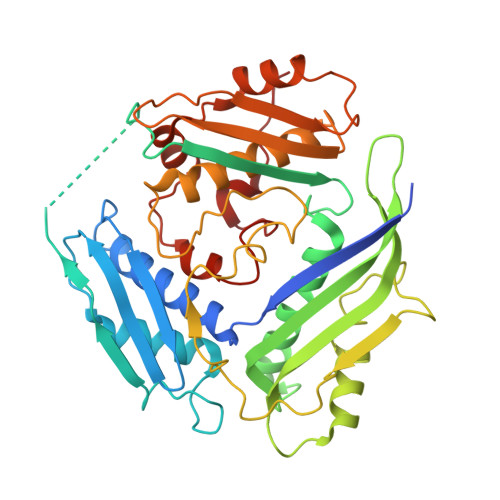Crystal Structures of Methionine Adenosyltransferase Complexed with Substrates and Products Reveal the Methionine-ATP Recognition and Give Insights Into the Catalytic Mechanism
Gonzalez, B., Pajares, M.A., Hermoso, J.A., Guillerm, D., Guillerm, G., Sanz-Aparicio, J.(2003) J Mol Biol 331: 407
- PubMed: 12888348
- DOI: https://doi.org/10.1016/s0022-2836(03)00728-9
- Primary Citation of Related Structures:
1O90, 1O92, 1O93, 1O9T - PubMed Abstract:
Methionine adenosyltransferases (MATs) are a family of enzymes in charge of synthesising S-adenosylmethionine (SAM), the most important methyl donor present in living organisms. These enzymes use methionine and ATP as reaction substrates, which react in a S(N)2 fashion where the sulphur atom from methionine attacks C5' from ATP while triphosphate chain is cleaved. A MAT liver specific isoenzyme has been detected, which exists in two distinct oligomeric forms, a dimer (MAT III) and a tetramer (MAT I). Our previously reported crystal structure of MAT I complexed with an inhibitor led to the identification of the methionine-binding site. We present here the results obtained from the complex of MAT I with a competitive inhibitor of methionine, (2S,4S)-amino-4,5-epoxypentanoic acid (AEP), which presents the same features at the methionine binding site reported before. We have also analysed several complexes of this enzyme with methionine and ATP and analogues of them, in order to characterise the interaction that is produced between both substrates. The crystal structures of the complexes reveal how the substrates recognise each other at the active site of the enzyme, and suggest a putative binding site for the product SAM. The residues involved in the interactions of substrates and products with MAT have been identified, and the results agree with all the previous data concerning mutagenesis experiments and crystallographic work. Moreover, all the information provided from the analysis of the complexes has allowed us to postulate a catalytic mechanism for this family of enzymes. In particular, we propose a key role for Lys182 in the correct positioning of the substrates, and Asp135(*), in stabilising the sulphonium group formed in the product (SAM).
Organizational Affiliation:
Grupo de Cristalografía Macromolecular y Biología Estructural, Instituto de Química-Física "Rocasolano", CSIC, Serrano 119, 28006 Madrid, Spain.


















